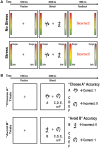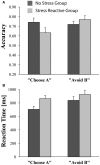Acute stress selectively reduces reward sensitivity
- PMID: 23596406
- PMCID: PMC3622896
- DOI: 10.3389/fnhum.2013.00133
Acute stress selectively reduces reward sensitivity
Abstract
Stress may promote the onset of psychopathology by disrupting reward processing. However, the extent to which stress impairs reward processing, rather than incentive processing more generally, is unclear. To evaluate the specificity of stress-induced reward processing disruption, 100 psychiatrically healthy females were administered a probabilistic stimulus selection task (PSST) that enabled comparison of sensitivity to reward-driven (Go) and punishment-driven (NoGo) learning under either "no stress" or "stress" (threat-of-shock) conditions. Cortisol samples and self-report measures were collected. Contrary to hypotheses, the groups did not differ significantly in task performance or cortisol reactivity. However, further analyses focusing only on individuals under "stress" who were high responders with regard to both cortisol reactivity and self-reported negative affect revealed reduced reward sensitivity relative to individuals tested in the "no stress" condition; importantly, these deficits were reward-specific. Overall, findings provide preliminary evidence that stress-reactive individuals show diminished sensitivity to reward, but not punishment, under stress. While such results highlight the possibility that stress-induced anhedonia might be an important mechanism linking stress to affective disorders, future studies are necessary to confirm this conjecture.
Keywords: affect-cognition interactions; anhedonia; cortisol; depression; emotion; punishment; reward; stress.
Figures




References
-
- American Psychiatric Association. (2000). Diagnostic and Statistical Manual of Mental disorders. (4th Edn, text revision). Washington, DC: American Psychiatric Press
-
- Beck A. T., Steer R. A., Brown G. K. (1996). Beck Depression Inventory Manual. 2nd Edn San Antonio, TX: The Psychological Corporation
-
- Berghorst L., Pizzagalli D. A. (2010). Defining depression endophenotypes, in Next Generation Antidepressants. Moving Beyond Monoamines To Discover Novel And Differentiated Treatment Strategies For Mood Disorders, eds Beyer C. E., Stahl S. A. (New York, NY: Cambridge University Press; ), 70–89
Grants and funding
LinkOut - more resources
Full Text Sources
Other Literature Sources

